

Python Lists. The most basic data structure in Python is the sequence.
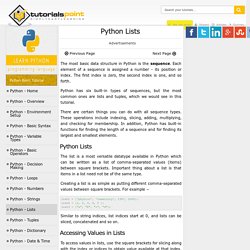
Each element of a sequence is assigned a number - its position or index. The first index is zero, the second index is one, and so forth. Python has six built-in types of sequences, but the most common ones are lists and tuples, which we would see in this tutorial. There are certain things you can do with all sequence types. These operations include indexing, slicing, adding, multiplying, and checking for membership.
Débuter avec Python au lycée. D’abord, qu’est-ce qu’un module ?

Il s’agit d’une sorte de bibliothèque (un regroupement de fonctions prédéfinies) qui une fois importée permet d’accéder à de nouvelles fonctions. Il en existe beaucoup. On peut citer : le module turtle qui permet de réaliser des dessins géométriques,le module numpy qui permet de faire du calcul scientifique,le module sympy qui permet de faire du calcul formel,le module matplotlib qui permet de faire des graphiques en tout genre. Pour ceux que cela interesse, il existe ce petit tutoriel pour débuter avec matplotlib .
Il y en a beaucoup d’autres, tant dans la nature ( que dans la bibliothèque standard ( voire des modules que vous aurez codés vous-mêmes. Programmation Python/Type. Un livre de Wikilivres.

L'objectif de cette section est la découverte des types de données Python et de la façon dont on les écrit sous forme littérale. L'étude complète des types complexes nécessite l'étude complète des structures de contrôle et sera donc abordée postérieurement. Type de données[modifier | modifier le wikicode] Python est un langage dont le typage est automatique. Cela signifie que bien que gérant différents types, lorsqu'une variable est affectée, l'interpréteur trouvera automatiquement son type. The Fibonacci sequence. Implementing the Fibonacci sequence is considered the "Hello, world!
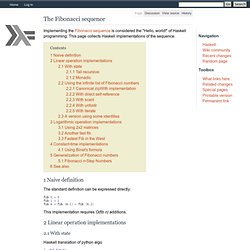
" of Haskell programming. This page collects Haskell implementations of the sequence. 1 Naive definition The standard definition can be expressed directly: Computer Science. Open Book Project. How to Think Like a Computer Scientist — How to Think Like a Computer Scientist: Learning with Python 3. Version date: October 2012 by Peter Wentworth, Jeffrey Elkner, Allen B.

Downey, and Chris Meyers (based on 2nd edition by Jeffrey Elkner, Allen B. Downey, and Chris Meyers) Corresponding author: p.wentworth@ru.ac.za Source repository is at For offline use, download a zip file of the html or a pdf version (the pdf is updated less often) from Search PageCopyright NoticeForewordPrefacePreface-3 This Rhodes Local Edition (RLE) of the bookContributor ListChapter 1 The way of the programChapter 2 Variables, expressions, and statementsChapter 3 Hello, little turtles! Project Euler. Welcome to Computer Science. KhanAcademy - List Sort Exercise (Min Sort)
GuiProgramming. Codecademy. Python. The Python Standard Library. While The Python Language Reference describes the exact syntax and semantics of the Python language, this library reference manual describes the standard library that is distributed with Python.
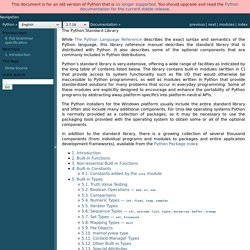
It also describes some of the optional components that are commonly included in Python distributions. Python’s standard library is very extensive, offering a wide range of facilities as indicated by the long table of contents listed below. The use of return and global keywords. Okay so here we have another post.
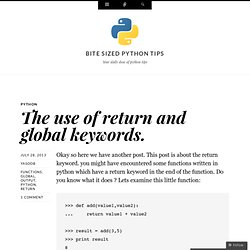
This post is about the return keyword. you might have encountered some functions written in python which have a return keyword in the end of the function. Do you know what it does ? Lets examine this little function: >>> def add(value1,value2): ... return value1 + value2 >>> result = add(3,5) >>> print result 8 The function above takes two values as input and then output their addition. CodingBat. 2. Built-in Functions. Open a file, returning an object of the file type described in section File Objects.
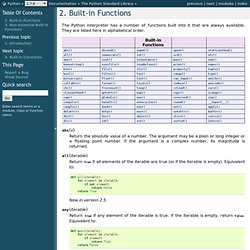
If the file cannot be opened, IOError is raised. When opening a file, it’s preferable to use open() instead of invoking the file constructor directly. The first two arguments are the same as for stdio‘s fopen(): name is the file name to be opened, and mode is a string indicating how the file is to be opened. The most commonly-used values of mode are 'r' for reading, 'w' for writing (truncating the file if it already exists), and 'a' for appending (which on some Unix systems means that all writes append to the end of the file regardless of the current seek position). If mode is omitted, it defaults to 'r'. The optional buffering argument specifies the file’s desired buffer size: 0 means unbuffered, 1 means line buffered, any other positive value means use a buffer of (approximately) that size (in bytes).
Welcome - Learn Python - Free Interactive Python Tutorial. Constants in Python. PyScripter-v2.5.3-x64-Setup.exe - pyscripter - PyScripter version v2.5.3 x64 - An open-source Python Integrated Development Environment (IDE) S Python Class - Educational Materials. Welcome to Google's Python Class -- this is a free class for people with a little bit of programming experience who want to learn Python.
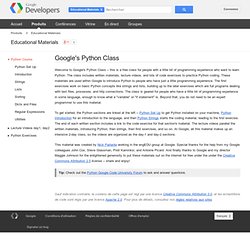
The class includes written materials, lecture videos, and lots of code exercises to practice Python coding. These materials are used within Google to introduce Python to people who have just a little programming experience. The first exercises work on basic Python concepts like strings and lists, building up to the later exercises which are full programs dealing with text files, processes, and http connections.
The class is geared for people who have a little bit of programming experience in some language, enough to know what a "variable" or "if statement" is. Beyond that, you do not need to be an expert programmer to use this material. This material was created by Nick Parlante working in the engEDU group at Google. S Python Class - Educational Materials.